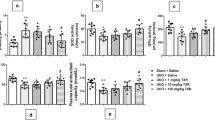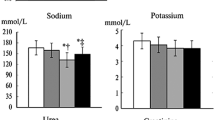Abstract
Introduction
Renal ischemia/reperfusion (I/R) which is an important cause of renal dysfunction is inevitable in renal transplantation, surgical revascularization of the renal artery, partial nephrectomy and treatment of suprarenal aortic aneurysms.
Aim
The purpose of this study was to investigate the efficacy of α-tocopherol and erdosteine combination in the reduction in injury induced by ROS in a rat model of renal ischemia–reperfusion.
Materials and methods
Thirty-six- male Wistar albino rats weighing 200–250 g were utilized for this study. Rats were divided into six groups, and each group was consistent of six rats: (1) sham-operated (control), (2) ischemia group (3) I/R group, (4) I/R/α-tocoferol group (5) I/erdosteine group (6). I/R/α-tocoferol and erdosteine group. Biochemically tissue MDA, XO and SOD activities, light and electron microscopic findings were evaluated.
Results
The erdosteine and α-tocoferol significantly reversed the effect of protein oxidation and lipid peroxidation induced by I/R shown by the decreased levels of MDA and XO activities. Both MDA and XO levels were found to be lower in group 6 compared to single agent treatment groups, and this was significantly different. All treatment groups showed increased SOD activity, which accounts for their oxidative properties. The mean Paller score of the combination treatment group (group 6) was lower than all groups except the sham group (3.67 ± 1.2), and this finding was statistically significant (0.05). Our results showed that the antioxidant pretreatment with α-tocopherol and erdosteine combination reduced lipid peroxidation of renal cellular membranes in a model of normothermic renal ischemia–reperfusion in rats. Combination of erdosteine and α-tocopherol has a synergistic effect of protection against oxidative processes. Long-term use of α-tocopherol seems to have a greater effect on the prevention of IR injury. However, further investigations are needed for the clinical applications of our findings.




Similar content being viewed by others
References
Bird JE, Milhoan K, Wilson CB, Young SG, Mundy CA, Parthasvathy S, Blantz RC (1988) Ischemic acute renal failure and antioxidant therapy in the rat: the relation between glomerular and tubular dysfunction. J Clin Invest 81(5):1630–1638
Walker LM, York JL, Imam SZ, Ali SF, Muldrew KL, Mayeux PR (2001) Oxidative stress and reactive nitrogen species generation during renal ischemia. Toxicol Sci 63(1):143–148
Nath KA, Norby SM (2000) Reactive oxygen species and acute renal failure. Am J Med 109(8):655–678
Noiri E, Nakao A, Uchida K, Tsukahara H, Ohno M, Fujita T, Brodsky S, Goligorsky MS (2001) Oxidative and nitrosative stress in acute renal ischemia. Am J Physiol Renal Physiol 281:F948–F957
Bolcal C, Yildirim V, Doganci S, Sargin M, Aydin A, Eken A, Ozal E, Kuralay E, Demirkilic U, Tatar H (2007) Protective effects of antioxidant medications on limb ischemia reperfusion injury. J Surg Res 139:274–279
Huk I, Nanobashvili J, Neumayer C, Punz A, Mueller M, Afkhampour K, Millboeck M, Losert U, Polterauer P, Roth E, Patten S, Malinski T (1997) L-Arginine treatment alters the kinetics of nitric oxide and superoxide release and reduces ischemia/reperfusion injury in skeletal muscle. Circulation 96:667
Dhalla NS, Elmoselhi AB, Hata T, Makino N (2000) Status of myocardial antioxidants in ischemia–reperfusion injury. Cardiovasc Res 47(3):446–456
Marchioli R, Schweiger C, Levantesi G, Tavazzi L, Valagussa F (2001) Antioxidant vitamins and prevention of cardiovascular disease: laboratory, epidemiological, and clinical trial data. Lipids 36:S53–S63
Jennings RB, Sommers HM, Smyth GA, Flock HA, Linn H (1960) Myocardial necrosis induced by temporary occlusion of a coronary artery in the dog. Arch Pathol 70:68–78
Cathherjee P (2000) Novel pharmacological approaches to the treatment of renal ischemia–reperfusion injury: a comprehensive study. Naunyn–Schmiedeberg’s Arch Pharmacol 376(1–2):1–43 (43)
Singh D, Chander V, Chopra K (2004) The effect of quercetin, a bioflavonoid on ischemia–reperfusion induced renal injury in rats. Arch Med Res 50:484–494
Minko T, Stefanov A, Pozharov V (2002) Lung hypoxia: antioxidant and antiapoptotic effects of liposomal α-tocopherol. J Appl Physiol 93:1550–1560
Avunduk MC, Yurdakul T, Erdemli E, Yavuz A (2003) Prevention of renal damage by alpha tocopherol in ischemia and reperfusion models of rats. Urol Res 31(4):280–285
Dechant KL, Noble S (1996) Erdosteine. Drugs 52(6):875–881
Anaya-Prado R, Toledo-Pereyra LH, Lentsch AB, Ward PA (2002) Ischemia/reperfusion injury. J Surg Res 105:248–258
Braga PC, Dal Sasso M, Zuccotti T (2000) Assessment of the antioxidant activity of the SH metabolite I of erdosteine on human neutrophil oxidative bursts. Arzneimittelforschung 50:739–746
Gurel A, Armutcu F, Cihan A, Numanoglu KV, Unalacak M (2000) Erdosteine improves oxidative damage in a rat model of renal ischemia–reperfusion injury. Eur Surg Res 133(4):399–401
Paller MS, Neuman TV (1991) Reactive oxygen species and rat renal epithelial cells during hypoxia and regeneration. Kidney Int 40:1041–1049
Draper HH, Csallony AS, Hadley N (2000) Urinary aldehydes as indicators of lipid peroxidation in vivo. Free Radic Biol Med 29(11):1071–1077
Sun JS, Lu FJ, Huang WC, Hou SM, Tsuang YH, Hang YS (1999) Antioxidant status following acute ischemic limb injury- a rabbit model. Free Radic Res 31(1):9–21
Durak I, Beduk Y, Kavutcu M, Ozturk S, Canbolat O, Ulutepe S (1997) Activities of superoxide dysmutase and glutathione peroxide enzymes in cancerous and noncancerous human kidney tissues. Int Urol Nephrol 29(1):5–11
Kirpatovskii VI, Stepina NI, Nadtochii ON (1993) Absence of a correlation between antioxidative and anti-ischemic effect of alpha-tocopherol in heat ischemia of the kidney. Patol Fiziol Eksp Ter 2:43–47
Rhoden EL, Pereira-Lima L, Teloken C, Lucas ML, Bello-Klein A, Rhoden CR (2001) Beneficial effect of alpha-tocopherol in renal ischemia–reperfusion in rats. Jpn J Pharmacol 87:164–166
Salahudeen AK, Wang C, Kanji VK (1996) Comparative study of the effect of 21-aminosteroid and alpha-tocopherol on models of acute oxidative renal injury. Free Radic Biol Med 21(5):691–697
Nath KA, Paller MS (1990) Dietary deficiency of antioxidants exacerbates ischemic injury in the rat kidney. Kidney Int 38:1109–1117
Granger DN, Hollwarth ME, Parks DA (1986) Ischemia–reperfusion injury: role of oxygen-derived free radicals. Acta Physiol Scand 548(suppl):47–63
Treska V, Kuntscher V, Hasman D, Neprasova P, Kobr J, Racek J, Trefil L, Hes O (2002) Importance of selenium for the influence of ischemia–reperfusion syndrome after kidney transplantation from a non-heart beating donor in a pig model. Transplant Proc 34:3057–3059
Fadıllıoglu E, Erdogan H (2003) Effects of erdosteine treatment against doxorubicin-induced toxicity through erythrocyte and plasma oxidant/antioxidant status in rats. Pharmacol Res 47(4):317–322
Uzun O, Balbay O, Comunoglu NU (2006) Hypobaric hypoxia-induced pulmonary damage in rats ameliorated by antioxidant erdosteine. Acta Histochem 108:59–68
Przyklenk K, Kloner RA (1989) “Reperfusion injury” by oxygen-derived free radicals? Effect of superoxide dismutase plus catalase, given at the time of reperfusion, on myocardial infarct size, contractile function, coronary microvasculature, and regional myocardial blood flow. Circ Res 64:86–96
Acknowledgments
This study was supported by the Selcuk University Research Fund.
Author information
Authors and Affiliations
Corresponding author
Additional information
An erratum to this article can be found at http://dx.doi.org/10.1007/s11255-009-9662-6
Rights and permissions
About this article
Cite this article
Yurdakul, T., Kulaksizoglu, H., Pişkin, M.M. et al. Combination antioxidant effect of α-tocoferol and erdosteine in ischemia–reperfusion injury in rat model. Int Urol Nephrol 42, 647–655 (2010). https://doi.org/10.1007/s11255-009-9641-y
Received:
Accepted:
Published:
Issue Date:
DOI: https://doi.org/10.1007/s11255-009-9641-y




